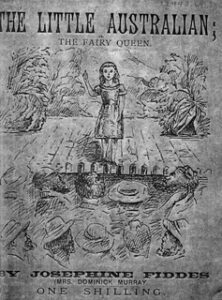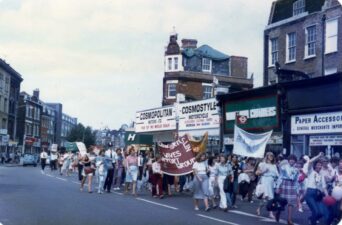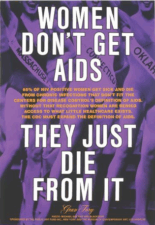Josephine Fiddes was an English actress, vocalist, author and playwright who graced stages across three continents during the 19th century. Her creative output extended beyond acting to directing, writing one-act monologues and authoring novels. The one publication that survives The Little Australian, Or The Fairy Queen offers a window into the harsh reality of theatre life in the colonies and the challenges faced by women.[1] Although a fictional work, it draws heavily on her experiences and observations of backstage life.
Thirteen-year-old Fiddes left Liverpool in 1852 with her mother, Harriet Cawse, a successful actress, playwright and music teacher, and younger sister embarking on a theatrical career which began with an 8-month tour of Honolulu and California. After being persuaded to join the legendary Lola Montez troupe they arrived in Melbourne in 1855 where the notoriety of Montez’s legendary Spider Dance created an uproar and gained attention.
After parting acrimoniously with Montez over an unpaid debt, Fiddes and her mother toured the neighbouring colonies bringing ‘entertainment of a character quite new to a South Australian audience’.[2] Their classical repertoire, including recitations of Longfellow and dramatic readings from Shakespeare delighted colonists in South Australia. Reviews indicate Fiddes was now much admired on stage and finally performing for a more refined audience; Government officials and their wives. With such praise theatre directors were quick to appreciate her drawing power as leading lady.
Travelling throughout the colonies, Fiddes often found herself partnered with Irish comedian Dominick Murray and their relationship developed between curtain calls. The impetuous eighteen-year-old eloped with Murray causing the cancellation of the night’s theatre performance, although returning to thunderous applause the following night as Mrs. Murray.
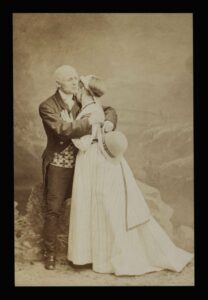
Fiddes’s career and fame quickly extended beyond London and she returned to the United States to an engagement at New York’s Grand Opera House. However, her time there was unsuccessful, leading to her departure from the venue after three weeks. Australian newspapers were incensed at the poor reviews of their favourite actress suggesting that she had not received ‘fair play on the boards’ from reviewers as she came from the ‘old country.’[3] Ignoring the bad press, Fiddes continued performing in major cities across the United States and Canada returning to New York in 1870 for a successful season at Wood’s Museum and Menagerie.
While female actors often remained in secondary roles, Fiddes adapted works to create roles designed to focus on her as an accomplished tragedienne that include Wilkie Collin’s ‘The Woman in White’.[4] Initially she wrote solely for the theatre, but around 1870 she began to write novels. While other books such as ‘Loved’ are tantalisingly advertised in newspapers they remain hidden.[5] Fortuitously one book published in 1882 survives. This copy of her slender novel archived in the Harvard University library has been rebirthed, digitised and is now offered as print-to-order on various websites for those interested in unearthing long forgotten stories.
The Little Australian, Or The Fairy Queen is semi-autobiographical detailing vividly the story of Bella, an orphan who finds herself forced to navigate the transient lifestyle of the theatrical world exploited, working long hours and with little protection. The tale follows a loose chronology that mirrors many of Fiddes’ experiences; the shock of arriving in dusty Melbourne, its Canvas Town swelled by diggers on their way to the goldfields, performing at The Charlie Napier Theatre to rowdy miners, being burnt by candles placed carelessly on stage, jealousy of talent, instability of employment and shady management practices.
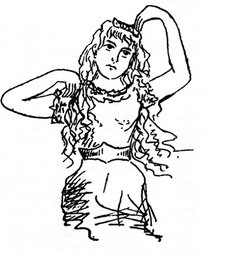
The backstage world explored in this book can be read as a microcosm of Victorian life; hierarchical, rigid in class and gender roles. Bella, like Fiddes seeks opportunities to make her fortune and find fame, desiring to be valued for her talent rather than it being exploited. Despite Bella escaping an arranged marriage, a circumstance initially accepted as her fate, and sailing to London where success seems within grasp, more skulduggery is afoot. Success is again out of reach. However, in a Cinderella style ending (spoiler alert) she is revealed to be the long-lost child of a wealthy gentleman. The theatrical life of instability, financial insecurity, social scrutiny and often gender-based moral judgement is abandoned. Bella is now a lady and has joined society’s respectable core.
Unearthing single copies of books written by women that may be hidden in library repositories is an opportunity to analyse and examine historical contexts from different perspectives. Every rediscovery of an unknown or under-appreciated woman or their works or achievements fills gaps in our understanding of women’s contributions to history, culture and literature. In this instance, digitisation of the only copy of The Little Australian, Or The Fairy Queen, has shed a spotlight on theatre life in the 19th century, ill-treatment and hardship backstage illuminated by the fiction of a well-known and successful actress, Josephine Fiddes.
Dr Robyn Floyd, formerly a school principal, is a lecturer in Humanities, Department of Education, University of Melbourne. Robyn is passionate about supporting teacher candidates to develop rich historical inquiries that engage and motivate their students. Her doctoral research explored the work of Olga Ernst, one of Australia’s earliest fairy tale writers investigating the social, political, and historical currents that inspired Ernst to create Australian fairies at the turn of the century. Her current research interests include micro-historical methodologies to recover marginalized voices and expand historical narratives through archival records.
Top image credit: Josephine Fiddes, Little Australian, Or The Fairy Queen (Hove Courier, 1882) Original from Harvard University. Digitised, Mar 3, 2009, Illustration Alex Binnie.
[1] Josephine Fiddes, Little Australian, Or The Fairy Queen (Hove Courier, 1882). Original from Harvard University. Digitised, Mar 3, 2009.
[2] “Lola Montez,” The Argus, July 3, 1909, 6; “Grand Concert,” Adelaide Times, January 11, 1856, 2.
[3] “English and Australian Actors in America,”Australasian, March 12, 1870, 18.
[4] Lancelot B. “The Drama in Sydney in the Sixties,” Evening News, September 15, 1900, 4.
[5] “Miss Fiddes”, The Era, March 2, 1879, 1.
